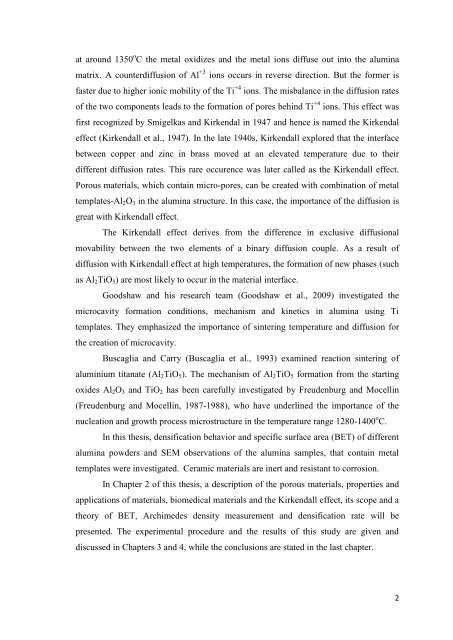use of metal templates for microcavity formation in alumina
use of metal templates for microcavity formation in alumina
use of metal templates for microcavity formation in alumina
You also want an ePaper? Increase the reach of your titles
YUMPU automatically turns print PDFs into web optimized ePapers that Google loves.
at around 1350 o C the <strong>metal</strong> oxidizes and the <strong>metal</strong> ions diff<strong>use</strong> out <strong>in</strong>to the alum<strong>in</strong>a<br />
matrix. A counterdiffusion <strong>of</strong> Al +3 ions occurs <strong>in</strong> reverse direction. But the <strong>for</strong>mer is<br />
faster due to higher ionic mobility <strong>of</strong> the Ti +4 ions. The misbalance <strong>in</strong> the diffusion rates<br />
<strong>of</strong> the two components leads to the <strong>for</strong>mation <strong>of</strong> pores beh<strong>in</strong>d Ti +4 ions. This effect was<br />
first recognized by Smigelkas and Kirkendal <strong>in</strong> 1947 and hence is named the Kirkendal<br />
effect (Kirkendall et al., 1947). In the late 1940s, Kirkendall explored that the <strong>in</strong>terface<br />
between copper and z<strong>in</strong>c <strong>in</strong> brass moved at an elevated temperature due to their<br />
different diffusion rates. This rare occurence was later called as the Kirkendall effect.<br />
Porous materials, which conta<strong>in</strong> micro-pores, can be created with comb<strong>in</strong>ation <strong>of</strong> <strong>metal</strong><br />
<strong>templates</strong>-Al2O3 <strong>in</strong> the alum<strong>in</strong>a structure. In this case, the importance <strong>of</strong> the diffusion is<br />
great with Kirkendall effect.<br />
The Kirkendall effect derives from the difference <strong>in</strong> exclusive diffusional<br />
movability between the two elements <strong>of</strong> a b<strong>in</strong>ary diffusion couple. As a result <strong>of</strong><br />
diffusion with Kirkendall effect at high temperatures, the <strong>for</strong>mation <strong>of</strong> new phases (such<br />
as Al2TiO5) are most likely to occur <strong>in</strong> the material <strong>in</strong>terface.<br />
Goodshaw and his research team (Goodshaw et al., 2009) <strong>in</strong>vestigated the<br />
<strong>microcavity</strong> <strong>for</strong>mation conditions, mechanism and k<strong>in</strong>etics <strong>in</strong> alum<strong>in</strong>a us<strong>in</strong>g Ti<br />
<strong>templates</strong>. They emphasized the importance <strong>of</strong> s<strong>in</strong>ter<strong>in</strong>g temperature and diffusion <strong>for</strong><br />
the creation <strong>of</strong> <strong>microcavity</strong>.<br />
Buscaglia and Carry (Buscaglia et al., 1993) exam<strong>in</strong>ed reaction s<strong>in</strong>ter<strong>in</strong>g <strong>of</strong><br />
alum<strong>in</strong>ium titanate (Al2TiO5). The mechanism <strong>of</strong> Al2TiO5 <strong>for</strong>mation from the start<strong>in</strong>g<br />
oxides Al2O3 and TiO2 has been carefully <strong>in</strong>vestigated by Freudenburg and Mocell<strong>in</strong><br />
(Freudenburg and Mocell<strong>in</strong>, 1987-1988), who have underl<strong>in</strong>ed the importance <strong>of</strong> the<br />
nucleation and growth process microstructure <strong>in</strong> the temperature range 1280-1400 o C.<br />
In this thesis, densification behavior and specific surface area (BET) <strong>of</strong> different<br />
alum<strong>in</strong>a powders and SEM observations <strong>of</strong> the alum<strong>in</strong>a samples, that conta<strong>in</strong> <strong>metal</strong><br />
<strong>templates</strong> were <strong>in</strong>vestigated. Ceramic materials are <strong>in</strong>ert and resistant to corrosion.<br />
In Chapter 2 <strong>of</strong> this thesis, a description <strong>of</strong> the porous materials, properties and<br />
applications <strong>of</strong> materials, biomedical materials and the Kirkendall effect, its scope and a<br />
theory <strong>of</strong> BET, Archimedes density measurement and densification rate will be<br />
presented. The experimental procedure and the results <strong>of</strong> this study are given and<br />
discussed <strong>in</strong> Chapters 3 and 4, while the conclusions are stated <strong>in</strong> the last chapter.<br />
2

















